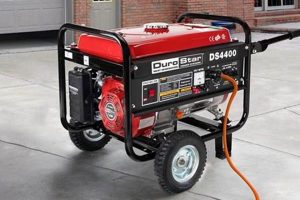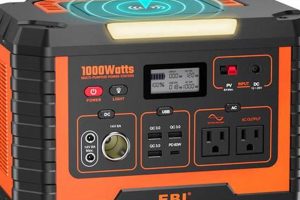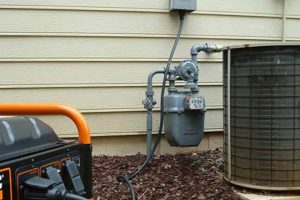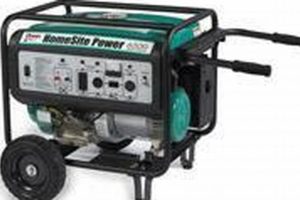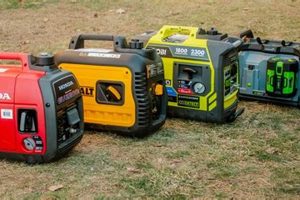Safely supplying backup power to a home during outages requires a transfer switch, a device that isolates the house circuits from the utility grid while connecting them to a generator. Several types of transfer switches exist, ranging from manual switches operated by the homeowner to fully automatic switches that detect an outage and activate the generator independently. Connecting a generator directly to household outlets through extension cords, a practice known as backfeeding, is extremely dangerous as it can energize downed power lines and pose a lethal threat to utility workers.
Providing a continuous power supply during emergencies offers significant advantages, safeguarding critical systems like heating, refrigeration, and medical equipment. The ability to maintain essential household functions during blackouts mitigates discomfort and potential safety risks. Historically, homes relied on rudimentary backup power solutions, but the development of portable generators and safe connection methods has revolutionized emergency preparedness. Effective implementation of these systems minimizes disruption during unforeseen power interruptions.
The following sections will delve into the different transfer switch options, safety protocols for generator operation, and a step-by-step guide to ensuring a secure connection between a portable generator and a home’s electrical system.
Safe Generator Connection Tips
Establishing a secure connection between a portable generator and a home’s electrical system requires careful planning and adherence to safety protocols. The following tips provide essential guidance for this process.
Tip 1: Consult a Qualified Electrician: Professional guidance ensures proper transfer switch selection and installation, mitigating potential hazards and ensuring code compliance.
Tip 2: Choose the Right Transfer Switch: Transfer switches must match the generator’s power output and the circuits intended for backup power. Options include manual, automatic, and interlock switches, each with its own advantages and installation requirements.
Tip 3: Never Backfeed: Directly connecting a generator to household outlets creates a dangerous backfeed condition, potentially energizing downed power lines and endangering utility workers. This practice should be strictly avoided.
Tip 4: Proper Grounding is Essential: Grounding the generator according to manufacturer instructions and local electrical codes prevents electrical shocks and ensures safe operation.
Tip 5: Adequate Ventilation: Generators produce carbon monoxide, a colorless, odorless, and lethal gas. Operate the generator outdoors in a well-ventilated area, far from windows, doors, and vents.
Tip 6: Fuel Safety: Allow the generator to cool completely before refueling to prevent fires. Store fuel in approved containers in a safe location.
Tip 7: Regular Maintenance: Periodically inspect the generator, transfer switch, and associated wiring for damage. Follow manufacturer recommendations for maintenance schedules and procedures.
Tip 8: Adhere to Local Codes and Regulations: Compliance with local electrical codes and permitting requirements is crucial for safety and legality.
Following these precautions ensures a safe and reliable backup power supply, protecting both the home and the individuals within it during power outages.
By understanding the importance of proper generator connection procedures and prioritizing safety, homeowners can effectively leverage portable generators to mitigate the impact of power disruptions.
1. Transfer Switch (Essential)
Safe connection of a portable generator to house power necessitates a transfer switch. This device acts as a critical safety barrier, preventing dangerous backfeeding and ensuring a smooth transition between utility power and generator power. Understanding the various facets of a transfer switch is crucial for effective generator integration.
- Types of Transfer Switches
Several transfer switch types exist, each offering distinct advantages. Manual transfer switches require user intervention to switch between power sources, offering a cost-effective solution. Automatic transfer switches detect outages and activate the generator automatically, providing uninterrupted power. Interlock switches, often integrated into the electrical panel, offer a streamlined and user-friendly approach. The chosen type influences installation complexity and operational convenience.
- Safety Implications
Transfer switches play a pivotal role in preventing backfeeding, a hazardous condition where electricity flows from the generator back into the utility grid. This poses a lethal threat to utility workers. A properly installed transfer switch isolates the home’s electrical system from the grid during generator operation, mitigating this risk and ensuring compliance with electrical safety standards.
- Installation Considerations
Transfer switch installation requires careful consideration of load requirements and local electrical codes. Determining the necessary amperage rating and selecting the appropriate wiring configurations are essential steps. Professional installation is highly recommended to ensure adherence to safety regulations and prevent costly errors.
- Impact on Power Restoration
Upon utility power restoration, the transfer switch facilitates a seamless transition back to the grid. With automatic transfer switches, this occurs automatically. Manual switches require user intervention to disconnect the generator and reconnect to the utility supply. This controlled switching process protects both the generator and household appliances from voltage fluctuations.
In summary, the transfer switch serves as an indispensable component in connecting a portable generator to house power. Its role in ensuring safety, managing power flow, and simplifying the transition between power sources underscores its importance in any backup power solution.
2. Never Backfeed (Critical)
Safe generator usage mandates a clear understanding of backfeeding and its inherent dangers. Connecting a generator directly to household outlets, known as backfeeding, presents a severe electrical hazard. This practice bypasses safety mechanisms and can lead to life-threatening consequences. Correct generator connection procedures prioritize safety and prevent such risks.
- Electrocution Risk to Utility Workers
Backfeeding energizes the utility lines assumed to be de-energized during an outage. Utility workers, operating under the assumption of a deactivated system, face potential electrocution. The seemingly inactive lines become lethal conductors, posing an immediate and severe threat.
- Damage to Appliances and the Generator
When utility power is restored, the clashing currents from the grid and the generator can create a power surge. This surge can severely damage appliances connected to the improperly configured system, as well as the generator itself. Such damage can lead to costly repairs or replacements.
- Fire Hazards
The uncontrolled flow of electricity during backfeeding creates an increased risk of overheating in both household wiring and the generator itself. This overheating can ignite flammable materials, leading to potentially devastating fires. Proper connection methods mitigate this risk significantly.
- Legal and Regulatory Violations
Backfeeding violates electrical codes and regulations designed to protect public safety. Engaging in this practice can result in significant fines or other legal penalties. Adherence to safety protocols ensures compliance and avoids such repercussions.
Avoiding backfeeding is paramount for safe generator operation. Utilizing a properly installed transfer switch eliminates this risk, ensuring the well-being of utility workers and protecting household equipment. This critical safety measure forms an integral part of responsible generator usage.
3. Proper Grounding (Safety)
Electrical grounding forms a critical safety component in portable generator connections, safeguarding against electrical shocks and equipment damage. A properly grounded generator provides a low-resistance path for fault currents to flow to the earth, preventing dangerous voltage buildup on the generator’s frame and connected appliances. Understanding grounding principles is essential for safe and effective generator operation during power outages.
- Protection Against Electrical Shock
Grounding serves as the primary defense against electrical shock. Should a fault occur within the generator or connected appliances, the grounding system directs the errant current safely into the earth, preventing it from passing through individuals who might come into contact with the equipment. This protective measure significantly reduces the risk of serious injury or electrocution.
- Preventing Equipment Damage
A properly grounded system safeguards sensitive electronic equipment connected to the generator. Grounding diverts surge currents, which can arise from lightning strikes or grid switching, away from sensitive components, minimizing the risk of damage to appliances and electronics. This protective mechanism preserves the functionality and longevity of connected devices.
- Stabilizing Voltage Levels
Grounding helps maintain stable voltage levels during generator operation. By providing a reference point for electrical potential, the grounding system minimizes voltage fluctuations, ensuring consistent and safe operation of connected appliances and preventing damage caused by voltage irregularities.
- Meeting Safety Codes and Regulations
Adherence to grounding requirements stipulated in national and local electrical codes is not only a safety imperative but also a legal requirement. Proper grounding ensures compliance with safety standards designed to protect both individuals and property. Ignoring these regulations can lead to penalties and potentially invalidate insurance coverage.
Effective grounding is paramount for safe and compliant portable generator operation. By providing a low-resistance path for fault currents, grounding protects individuals from electrical shock, safeguards connected equipment from damage, and ensures the stable operation of the generator system. Understanding and implementing proper grounding techniques contributes significantly to overall electrical safety during power outages.
4. Outlets/Circuits (Planning)
Effective integration of a portable generator into a home’s electrical system requires careful circuit planning. This involves identifying essential circuits and appliances, calculating their power requirements, and ensuring the generator’s capacity aligns with the anticipated load. Strategic circuit planning maximizes the generator’s utility during outages while preventing overload and ensuring safe operation.
- Essential vs. Non-Essential Circuits
Distinguishing between essential and non-essential circuits is crucial for efficient power allocation during outages. Essential circuits typically power critical systems like refrigerators, freezers, furnaces, and well pumps. Non-essential circuits, powering items like entertainment systems and non-essential lighting, can be omitted during generator operation to conserve fuel and prevent overload. Prioritization ensures critical systems remain operational.
- Calculating Power Requirements
Accurately calculating the wattage requirements of intended circuits is essential. Each appliance has a specific power draw, typically indicated on its label or in its documentation. Summing these wattages provides the total power demand the generator must meet. Overestimating ensures adequate capacity while underestimating can lead to overload and generator shutdown.
- Load Management and Prioritization
Strategic load management optimizes generator usage. Operating high-wattage appliances like electric water heaters or ovens individually, rather than concurrently, prevents exceeding the generator’s capacity. Prioritizing essential loads ensures critical functions are maintained during outages, while judicious use of non-essential circuits extends generator runtime and fuel efficiency.
- Transfer Switch Configuration
The transfer switch configuration directly impacts which circuits receive generator power. Some transfer switches power only specific, pre-selected circuits, while others provide power to the entire electrical panel. Choosing the appropriate transfer switch configuration aligns with the homeowner’s needs and ensures essential circuits are prioritized during outages.
Careful planning of outlets and circuits is integral to successful generator integration. Understanding power needs, prioritizing essential circuits, and properly configuring the transfer switch maximizes the generator’s effectiveness and ensures a safe and reliable backup power supply during outages. This planning process forms the foundation for a robust and efficient emergency power solution.
5. Generator Size (Wattage)
Appropriate generator sizing is paramount for successful integration with a home’s electrical system. Connecting a portable generator requires careful consideration of wattage requirements to ensure sufficient power for essential circuits during outages. Undersized generators lead to overloads and potential damage, while oversized generators represent unnecessary expense and fuel consumption. Accurate wattage assessment is crucial for effective and efficient backup power.
- Starting vs. Running Watts
Electrical devices often require a higher surge of power to start, known as starting wattage, compared to the power needed to maintain operation, known as running wattage. Motors, such as those found in refrigerators and air conditioners, exemplify this phenomenon. Generator selection must account for the highest starting wattage of any intended appliance to prevent stalling during startup. For instance, a refrigerator might have a running wattage of 200 watts but require a starting wattage of 1000 watts. Ignoring this distinction can lead to insufficient power supply during appliance startup.
- Calculating Total Wattage Requirements
Determining the cumulative wattage needs of all intended circuits requires summing the running wattages of each appliance and factoring in the highest starting wattage among them. This calculation provides the minimum generator wattage necessary to power the selected circuits simultaneously. For example, a homeowner intending to power a 1000-watt microwave, a 500-watt sump pump, and a 200-watt refrigerator, with the microwave having the highest starting wattage of 1500 watts, would require a generator capable of handling at least 1700 running watts and 1500 starting watts. This ensures adequate power for simultaneous operation.
- Impact of Generator Size on Fuel Consumption
Generator size directly influences fuel consumption. Larger generators consume more fuel per hour, even when operating below their maximum capacity. Selecting a generator appropriately sized for the intended load minimizes fuel usage, reduces operating costs, and extends runtime during extended outages. Choosing a generator substantially larger than necessary leads to inefficient fuel usage and unnecessary expenses.
- Considering Future Expansion
Anticipating future power needs influences generator selection. If future appliance additions or electrical system upgrades are anticipated, opting for a slightly larger generator than currently required provides flexibility and avoids the need for replacement in the near future. This forward-thinking approach simplifies future expansion and ensures the generator remains adequate for evolving power demands.
Understanding wattage requirements is fundamental to selecting a portable generator suitable for a home’s electrical system. Accurately assessing power needs, distinguishing between starting and running watts, and considering future expansion ensures the chosen generator can reliably power essential circuits during outages without overloading or wasting fuel. This knowledge forms a critical component of a comprehensive backup power strategy.
6. Fuel Type (Gasoline/Propane)
Fuel type selection significantly impacts portable generator usability and logistical considerations for home backup power. Gasoline and propane, the most common generator fuels, each possess distinct characteristics influencing storage, availability, and operational aspects. Understanding these differences is crucial for seamless generator integration and sustained performance during outages.
Gasoline offers widespread availability and generally higher energy density compared to propane. This translates to longer runtimes on a given fuel volume. However, gasoline has a limited shelf life, degrading over time and potentially causing carburetor issues. Storage requires approved containers and precautions against spills and fumes. For example, a homeowner relying on gasoline for a generator might encounter starting difficulties after an extended period of storage if the fuel has degraded. Propane, conversely, offers indefinite shelf life and cleaner combustion, reducing maintenance requirements. Propane requires specialized tanks and regulators, influencing storage space and initial setup costs. A homeowner opting for propane might appreciate the simplified long-term storage but face higher initial investment in tanks and connections. Dual-fuel generators offer flexibility, utilizing either gasoline or propane, catering to situational fuel availability and individual preferences. This adaptability proves valuable in areas with fluctuating fuel supplies or during emergencies where one fuel type becomes scarce.
Fuel type considerations extend beyond mere availability and storage. Propane’s clean-burning properties minimize environmental impact and reduce maintenance needs compared to gasoline. However, propane’s lower energy density necessitates larger tank volumes for equivalent runtime compared to gasoline. Ultimately, fuel type selection depends on individual circumstances, balancing factors like storage capacity, runtime requirements, environmental concerns, and fuel availability. Careful consideration of these factors ensures the chosen fuel type aligns with the homeowner’s specific needs and operational context. This informed decision contributes significantly to the overall effectiveness and practicality of the backup power solution.
7. Professional Installation (Recommended)
While connecting a portable generator might appear straightforward, professional installation offers significant advantages in terms of safety, code compliance, and long-term reliability. Incorrectly connecting a generator can lead to dangerous situations, including fires, electrocution, and damage to appliances. Professional expertise ensures the system adheres to safety standards and operates effectively.
- Safety and Code Compliance
Licensed electricians possess the knowledge and experience to install transfer switches and wiring in accordance with local electrical codes and National Electrical Code (NEC) requirements. This ensures the system operates safely and mitigates potential hazards such as backfeeding and improper grounding. For example, an electrician will ensure proper wire sizing and grounding techniques to prevent overheating and electrical shocks. Failure to adhere to code requirements can invalidate homeowner’s insurance in the event of an incident.
- Correct Transfer Switch Selection and Installation
Choosing the appropriate transfer switch for a specific generator and electrical system requires technical expertise. Professionals assess the home’s power needs and recommend the correct type and amperage rating for the transfer switch. Correct installation ensures seamless switching between utility power and generator power and prevents damage to the generator and connected appliances. An incorrectly sized or installed transfer switch can lead to system failure during an outage.
- Proper Wiring and Grounding
Correct wiring and grounding are crucial for preventing electrical shocks and fire hazards. Professionals ensure all connections are secure, properly insulated, and grounded according to code. This meticulous approach safeguards against electrical faults and protects both the home and its occupants. Improper grounding can create a path for stray currents, leading to electrocution risks.
- Long-Term Reliability and Peace of Mind
Professional installation provides long-term reliability and peace of mind. Knowing the system is installed correctly and meets all safety standards assures homeowners of its effectiveness during outages. This reduces stress and uncertainty during emergencies. A professionally installed system minimizes the risk of malfunctions and ensures a dependable power supply when needed most.
Given the potential dangers and complexities associated with connecting a portable generator to house power, professional installation is highly recommended. The expertise of a licensed electrician ensures the system adheres to safety standards, operates reliably, and provides a secure source of backup power during outages. This investment in professional installation offers invaluable peace of mind and safeguards against potential hazards, ensuring a dependable and safe power solution for the homeowner.
Frequently Asked Questions
Addressing common inquiries regarding safe and effective generator connections can clarify potential uncertainties and promote best practices.
Question 1: What is the safest way to connect a portable generator to home circuits?
Utilizing a properly installed transfer switch is the only safe method. Transfer switches isolate the home’s electrical system from the utility grid, preventing backfeeding and ensuring safe generator operation. Direct connection to outlets or the electrical panel without a transfer switch poses significant risks.
Question 2: Is professional installation necessary for a transfer switch?
Professional installation by a licensed electrician is strongly recommended. Electricians possess the expertise to ensure proper wiring, grounding, and adherence to local electrical codes, maximizing safety and system reliability.
Question 3: Can any portable generator power an entire house?
Generator capacity must align with the home’s power requirements. Calculating the total wattage of essential circuits determines the necessary generator size. Attempting to power excessive loads with an undersized generator leads to overloads and potential damage.
Question 4: What are the dangers of backfeeding a generator?
Backfeeding, connecting a generator directly to outlets, creates a life-threatening hazard for utility workers. It energizes downed power lines assumed to be de-energized. Additionally, backfeeding can damage appliances and the generator when utility power is restored.
Question 5: How does generator grounding contribute to safety?
Grounding provides a low-resistance path for fault currents to flow to the earth, preventing electrical shocks. A properly grounded generator protects individuals and equipment from electrical hazards. Grounding is crucial for safe operation.
Question 6: What maintenance is required for a portable generator?
Regular maintenance, including oil changes, air filter cleaning, and spark plug replacement, ensures optimal generator performance and longevity. Consulting the manufacturer’s recommendations provides specific maintenance schedules and procedures.
Understanding these key aspects of generator connection promotes safe and effective backup power solutions, mitigating risks and ensuring reliable operation during outages.
For further guidance or specific inquiries regarding individual circumstances, consulting a qualified electrician is highly recommended.
Connecting a Portable Generator to House Power
Establishing a safe and reliable connection between a portable generator and a home’s electrical system requires careful planning and execution. Utilizing a properly installed transfer switch is paramount, eliminating the dangers of backfeeding and ensuring a secure transition between utility power and generator power. Adequate generator sizing, based on calculated wattage requirements, guarantees sufficient power for essential circuits during outages. Furthermore, proper grounding practices and adherence to safety protocols are crucial for protecting individuals and equipment from electrical hazards. Selecting an appropriate fuel type and understanding its storage and handling requirements further contributes to a well-prepared and functional backup power solution.
Investing in a robust and correctly implemented generator connection system provides invaluable peace of mind during unforeseen power disruptions. Safeguarding a home’s essential functions during outages contributes significantly to comfort, security, and the preservation of vital systems. Prioritizing safety and adhering to established best practices ensures a dependable and effective backup power solution, mitigating the impact of power outages and enhancing overall preparedness.


